Giant dog breeds have been around since antiquity helping people in a variety of different ways.
Each had a job to do such as guarding or herding, pulling a cart or hunting large prey. Their massive size and thick muscular builds proved invaluable even to Stone Age people.
Their confidence and independent natures allowed them to work independently of people making them especially good at guarding.
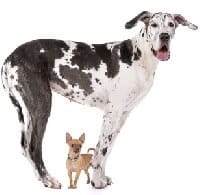
Many could be docile and loving, keeping people warm at night, but then react instantaneously if the need arose.
Today, Giant Dog Breeds are still be used in many of the same ways as they have done for millennia, but most are also beloved members of a family.
Breeders have tried to breed out some of those less desirable traits that made them fierce but effective guardians. This makes them better household pets, but they do retain some of those old traits.
Best Type of Owners
As a general rule, large breed dogs such as those on these pages require an experienced confident owner.
They need early and continual socialization and extensive training. Owners who are willing and able to take the time needed for these tasks are rewarded with a well behaved family dog.
Without training and socialization, these giant dog breeds can easily become uncontrollable and some end up in shelters. No first time dog owner should attempt a large breed without assistance.
Just How Big is Big?
Giant dog breeds do not have an official height or weight that makes them massive, but those found on these pages are all at least 80 pounds and most are much heavier than that.
Sometimes it is the height of the breed that makes them huge. We determine the height of the dog by measuring from the ground up to the withers (the highest point on the dog’s back, just behind the neck).
This method of measure does not account for the size of the head, so keep that in mind when envisioning the size of these giant dog breeds. All of these breeds have a height of at least 30 inches.
Side note:
When I helped out at the local boarding kennels I remember a Great Dane came in along with his friend who was a little Yorkshire Terrier. That’s a 34 inch dog who was friends with a 6 inch dog!
It was so funny to see them together and they were so different in temperament. The Great Dane was an absolute gentle giant – very calm, friendly and laid back. While the Yorkshire Terrier was very active and ran around the place, barking his little head off!
The Great Dane was so laid back that when I walked past later on, he had the little Yorkshire Terrier asleep on his head – very cute! Ever since then I’ve had a soft spot for Great Danes. Plus they look like Scooby Do!
Choosing one of the Giant Dog Breeds
If you decide that a giant dog breed is for you then there’s a few things you have to consider before bringing one home.
Food
One is that as a puppy, you may have to feed them special food specifically for large breed puppies. This helps to control the rate at which they grow so that unnecessary strain isn’t put onto their joints which can happen if they grow too quickly.
You might also want to consider an Anti-Gulp Food Bowl as giant dog breeds have a tendancy to gulp their food down incredibly quickly which can cause problems with bloating and stomach twisting.

FURminator deShedding Tool
We have found that the absolute best way of grooming any long haired dog breed is to use the FURminator grooming tool! We highly recommend this unique brush from Amazon to keep your dog in tip top shape. Click on the image below to find out more…

Cleanup
AND, what goes in, comes out, so if a 200 pound dog is on your radar, remember to make time for cleanup.
As well as costing more to feed, will you be able to lift a fully grown giant dog to take him to the vet if he becomes too sick or injured to move? Are you strong enough to train your dog to walk nicely on a leash without pulling?
Expenses
Food is not the only thing that will cost more. Consider your budget. The larger the dog, the larger the accessories, the higher the price tag: Large Crate, Large Bed, Large Toys, Large Chews…
Space
And, while we’re talking about large, remember that giant dog breeds need more space, just to spread out and relax. A large house is not mandatory, but it sure helps. A big sofa helps especially if the giant dog breed of your dreams thinks of himself as a lap dog.
A decent size car is a must. They must be able to fit into your car, even if it is to go the vets, groomers, or trainers.
Travel Arrangements
If you travel, will your dog accompany you? On the road? In the Air? Or, will you board him? Boarding and grooming is always more expensive for larger breed dogs.
Think it through and do as much research on the breed you decide upon. Here are just a few of the world’s giant dog breeds.
Giant Dog Breeds
These dogs are listed in alphabetical order, but their sizes vary. They all fall into the classification of 88 pounds (40 kg) or larger.
You might find some of them listed in the Large Dog Breed pages because some members of the breed may be slightly smaller. Males are generally larger than females and breed standards do not always specify weight.
Alaskan Malamute
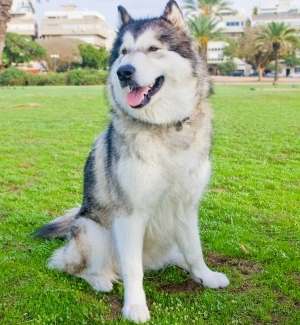
Large and strong, rather than fast, the Alaskan Malamute evolved in the Arctic region where they served as hunting partners for big game such as polar bears and seals and for pulling sleds. Although an ancient breed, Alaska in the U.S. is credited with developing them to modern times.
They are powerful, strong willed, and independent, but they are also family oriented and always ready for some fun.
They need a great deal of exercise, but they are friendly and very social, but not necessarily to strange dogs. These dogs are much better in colder climates and will need some air-conditioned quarters in warmer months.
Males weigh in at about 85 pounds on average and the girls are slightly smaller.
American Akita
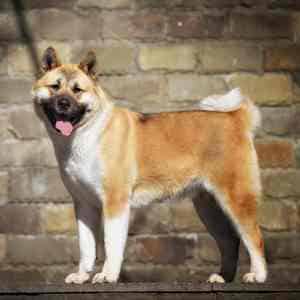
Playful and extremely affectionate with their families, the American Akita is also a powerful guardian.
We’ve placed them in this group of giants because some have gotten to be as large as 150 pounds. Not the best choice for families with small children or multi-dog households, these dogs are larger than their Japanese cousins (Akita Inu) but less suspicious of strangers.
They will require an experienced owner willing to take time to socialize and training their puppy from the day the puppy enters the home. They are considered a “working” dog and they are at their best with a job to do. If no job is available plenty of daily exercise will fulfill their energy needs and keep them happy and well-balanced.
American Bulldog

The American Bulldog is one of those breeds that could be considered large in size rather than giant. I placed it here because some of the members of the breed can grow to upwards of 120 pounds. Match strength, confidence, and size and you have a dog to be reckoned with if not trained and socialized properly.
With the right owner, right training, and right socialization, these dogs make excellent family pets, gentle with children and completely devoted to their family.
Some have problems getting along with other dogs, especially those of the same sex, and a few do not do well with other family members.
Anatolian Shepherd Dog
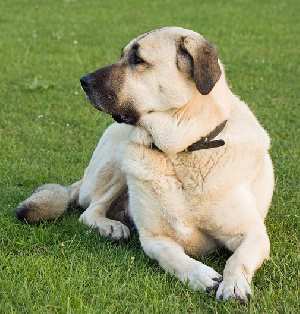
Also going by the name Coban Kopegi, Kangal Dog or Karabash Dog, these dogs one variety of sheepdogs originating in the Anatolian region of Turkey.
Naturally protective and suspicious, these dogs were used to protect flocks, and now they continue to make excellent guard dogs.
They require extensive socialization and training to make them a suitable family pet.
At between 90 and 141 pounds (41-64 kg) and 28 to 32 inches (71-81 cm), these dogs require a firm and experienced owner, willing to take the time needed to properly socialize and train these dogs from day one.
Despite the name, these dogs are guardians, not herders of livestock.
Bernese Mountain Dog
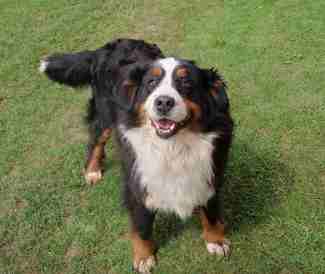
Could the Bernese Mountain Dog be traced to Roman times? Many think so and have determined that Roman mastiffs were crossed with some of the local flock guarding dogs to produce a dog able to withstand the harsh climate of the Alpine Mountains.
Today, they are easy going, calm and friendly. A great choice for a family with children, they are extremely devoted and love the playful activity that accompanies young children. They do much better in the cold than in the heat and will need a good walk or hike daily.
At 90-120 pounds for the males and slightly smaller for the females, expect these dogs to mature slowly and consume a lot of food!
Bloodhound
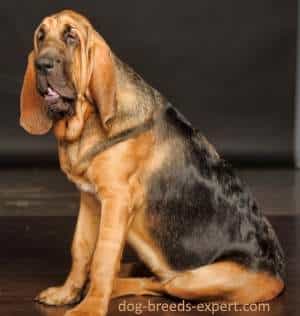
The Bloodhound can trace their earliest ancestors to ancient times. William the Conqueror is credited with bringing hounds to England in 1066 and the breed was developed mostly in monasteries.
Their names refers to their pure bloodline and noble breeding. In the U.S., these dogs were used to trail people, giving them a bad name. People thought that these dogs trailed people for their blood, which couldn’t be further from the truth.
They make excellent hunters, and search and rescue dogs, but in the house, they are calm and gentle. They do very well around children, but reserved around strangers.
Training for trailing activities is much easier to accomplish with these dogs than basic obedience. Their coat care is minimal except that they are big droolers and their ears tend to fall into their food.
Boys average 90 pounds but can be as much as 110lbs. Most owners have said that their Bloodhounds are heavier than what is generally recorded for the breed.
Boerboel
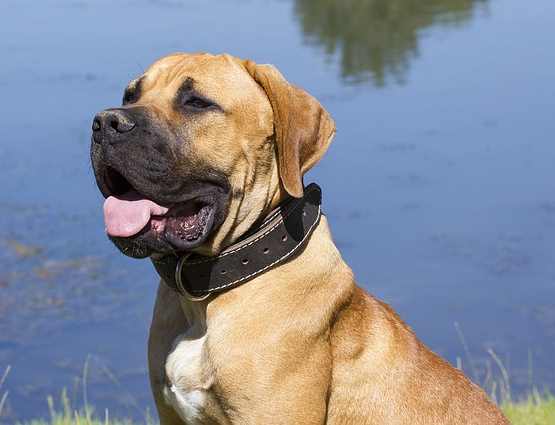
One of the largest of all the African breeds, the Boerboel name (pronounced BUR-Bul) means farmer’s dog. In Africa, farmers needed plenty of protection from dangerous animals.
They are protective, independent and strong-willed but also highly intelligent. This would not be a good choice for a novice dog owner.
They require ongoing training, but they are very affectionate with the people they love. They love a good walk or job daily and won’t be much of a burden when it comes to grooming.
Males weigh in at 140-180 lbs and the females are somewhat smaller at 100-130 lb.
Borzoi (Russian Wolfhound)

This Sight-hound from Russia was a very popular hunter up to the Russian Revolution where they may have died out if it wasn’t for foreigners who carried on the lineage.
They are quiet and well mannered in the house, but open the door, and these dogs are the ultimate racers, chasing anything that can run. They are good with children, but not as playful as some children may like. Their exercise needs are great and their coat requires brushing about 3 times a week.
While not as popular as a pet, they make a great show dog and participate in sports such as Lure coursing. At 30 inches in height, they make a formidable appearance. Males weigh between 75 and 105 pounds and females are generally between 60 and 85 pounds.
Bullmastiff

The Bullmastiff originated in England near the end of the nineteenth centruy and is a cross between a mastiff and bulldog. Poaching on large estates was a big problem and gamekeepers needed some protection.
Today, the Bullmastiff is a gentle, quiet breed and devoted companion. They love people but may not tolerate other dogs. To meet their exercise needs, they will require daily walks and short romps in the yard. Coat care, however, is minimal. This is one of those breeds that may drool.
Males are usually in the 110 to 130 pound range and the females are smaller at 100-120 pounds. They are also quite tall reaching up to 27 inches at the shoulders.
Cane Corso
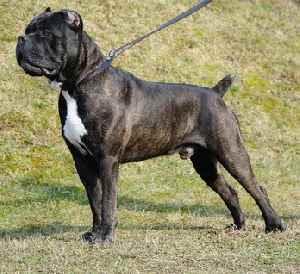
Weighing in at over 100 pounds, there’s no question that the Cane Corso meets the criteria for being one of the giant dog breeds.
Being part of rural Italy for a thousand years, these dogs performed a variety of tasks. Hunting large dangerous game and protecting livestock from wolves were just some of the tasks these loyal devoted dogs accomplished.
These dogs are not for everyone. They need an assertive confident owner and a large fenced yard for exercise. Appearance wise, they resemble most of the molossus breeds with strong, thick muscles and a big head.
Caucasian Shepherd dog

This breed, also known as the Kavkazskaya Ovtcharka or Caucasian Ovetcharka is a popular Russian Sheepdog, which was used as a guard dog between the divided Germany during the time of the former USSR.
If bred and socialized correctly they can make good family pets, but are most known for their guarding ability.
Their independent nature and self-confidence make them safe within the family, but dangerous to strangers.
They stand 25 to 28 inches high (64-72 cm) and weigh between 99 and 154 pounds (45-70 kg).
Dogue de Bordeaux (aka. French Mastiff)
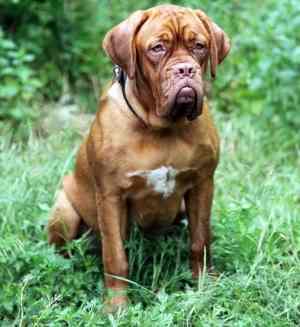
Often called the French Mastiff (dogue in French means Mastiff), these dogs are the ultimate guard dog, willing to risk their lives to protect their family.
His size and stature make him a natural guard dog, he is agile but not aggressive. This old French breed weighs between 99-110+ lbs (45-50 kg), and has a height of 23 to 27+ inches (58-68 cm).
Rarely seen outside of France, the Dogue de Bordeaux made his world debut with the 1989 comedy film, ‘Turner and Hooch’. From then on, Americans fell in love with the breed and their popular has risen since then.
These dogs require very experienced owners willing to take the time and patience for training and socialization. They drool, and snore.
English Mastiff

The English Mastiff or just Mastiff for short, is typical of the group of ancient dogs known by the same name. During Roman Times, they were considered war dogs and by the Medieval period, they were being used as guard and hunting dogs. Later they were used for dog fighting, and bull and bear baiting.
Despite his history, the mastiff is a good natured, calm and gentle house pet. Very loyal, he is devoted to his family and great with children. The need daily exercise, but coat care is minimal. This is one of those dogs that drool, be ready with a rag.
Their weight ranges between 175 and 190 pounds and they can stand as tall as 30 inches at the withers.
Estrela Mountain Dog (Cão da Serra da Estrela)
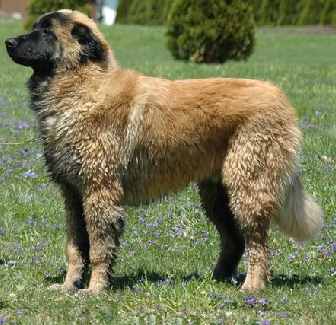
The Estrela Mountain Dog is considered one of the oldest breeds from Portugal. Used to herd and guard flocks in mountainous terrains, shepherds needed dogs that were large, strong, agile, and watchful. Over the years, these dogs developed all of these characteristics and more.
Today they make great companions, but they can be stubborn and you will need to be committed to training and early socialization. They are loyal and devoted to their families but aloof with strangers.
At up to 110 pounds, these dogs may look like giant teddy bears, but they should not be treated as such. They need room to romp and play in a fenced in area and walks on a leash.
Great Dane
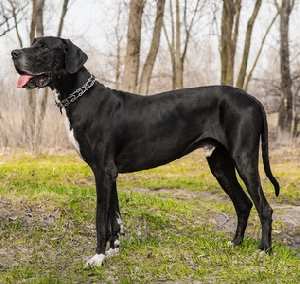
Like all mastiff breeds, the Great Dane’s origins are in Asia but the dog we know today was developed in Europe.
Once a hunting dog, they are not quite content to be a house dog and family pet, preferring a comfortable place to rest, if not on their owner’s lap. At upwards of 175 pounds, this can be just a little too heavy for some people.
They are a most elegant and distinguished giant, but if you want large, they don’t come bigger than this, bar the Irish Wolfhound. Prepare yourself by purchasing a large home, a large car, big sturdy furniture, and a huge sofa, and be prepared to buy lots of dog food!
Greater Swiss Mountain Dog
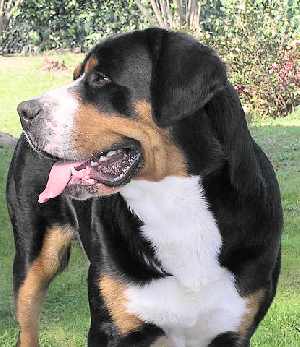
Relaxed, loyal and protective describes these giant dogs that were developed in the Swiss Alps. During the breed’s history, they had several jobs to do, but the main one involved pulling carts. Like all giant dogs, space is a must for the Greater Swiss Mountain Dog.
They prefer cooler climates but do well with children and are relatively easy to train. They have retained some of their guarding instincts so they can double as a guard dog. They are prone to many of the health problems of larger dogs and do drool, so be prepared.
Hungarian Kuvasz
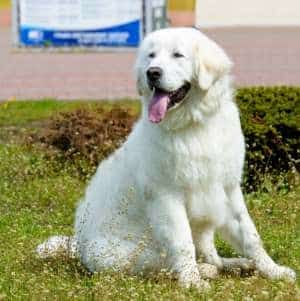
The Kuvasz is well known as a Hungarian guard dog throughout Europe. Owners value the breed for its intelligence and ability to act independently while still remaining loyal and protective of family.
Alongside their working aptitudes, they make for playful and affectionate companions especially with his family. They are very protective of their children, but may be reserved with strangers.
You’d better like the color white, because this is the only shade available, and at 70 to 115 pounds, you can be sure he’ll guard and protect you. Prepare for daily exercise and a fair amount of coat care.
Irish Wolfhound

Standing at a minimum of 32+ inches, and weighing in at a minimum of 120lbs +, these giants have been prized from ancient times. Having first arrived in Ireland by way of Greece in the 1500 B.C., they were originally used to hunt giant Irish Elk, and then wolves. As wolves became extinct in Ireland in the eighteenth century, these dogs’ numbers also declined.
Today they are known as gentle giants, displaying a personality that is confident, calm, sensitive, and patient. Despite their size, they are good with children, pets, other dogs and strangers.
They need plenty of room, especially a big comfortable bed on which to stretch out. They also require daily exercise and a fair amount of coat care.
Japanese Tosa Inu
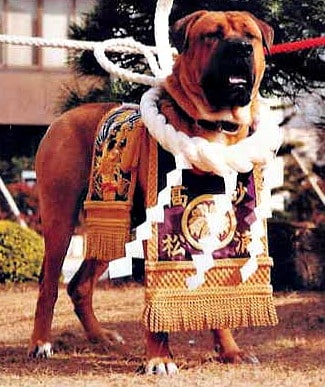
Rare in the United States and even in Japan, their native land, these giants carry the legacy of their fighting ancestors.
Today’s Tosa Inu comes from the smaller Japanese fighting mastiffs that were later crossed with Great Danes, Bulldogs, and European Mastiffs.
The additions of these other breeds added to their size and strength and allowed them to reach heights of up to 26 inches (65 cm) and almost 200 pounds.
The males are larger than the females. Their size and strength coupled with their latent fighting instinct makes them a breed appropriate only for expert owners.
Kangal Shepherd (Anatolian Shepherd)
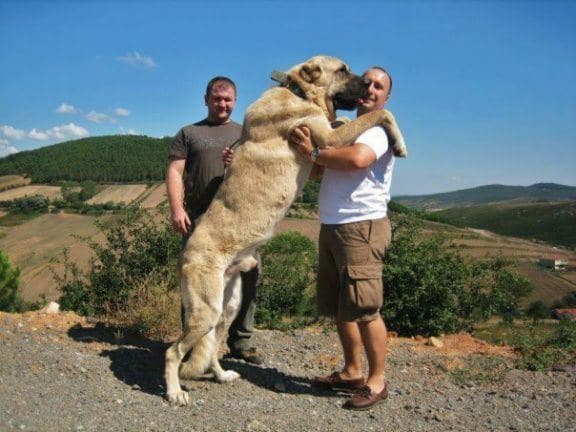
The National Dog of Turkey, this breed originated in the province of Anatolia thousands of years ago. It was bred to guard and protect flocks of sheep and goats from wolves, jackals and even bears. More recently is has also been used in Namibia and Kenya to deter Cheetahs from farm livestock, with great success.
This is a big dog, standing 30 to 32 inches high at the withers, and male dogs weighing up to 140lbs.
The Kangal is calm, confident, and very protective of its family, and is good with children. However it is suspicious of strangers, and needs early and thorough socialization during all of its puppy hood.
Komondor

The passage of time has obscured the origins of this breed but the best evidence we have is that they began with a nomadic Turkic people who settled in central Hungary.
A quick look at the Komondor will tell you how uniquely different he looks from other giant breed dogs. His all white corded coat probably protected him from the elements as well as providing a bit of protection from being kicked, clawed or bitten.
Komondors tend to be territorial, but calm as adults. They can be very fast and their protective instincts can be triggered at a moment’s notice. He is a calm, self-assured dog that’s hard to train because of their independent nature.
As a family dog, he can be very loyal , but his naturally high guarding instincts along with his size and strength make him an intimidating guard dog.
At 25 inches high at the withers (63 cm) and up to 135 pounds, these dogs are one of the world’s largest dogs.
Leonberger
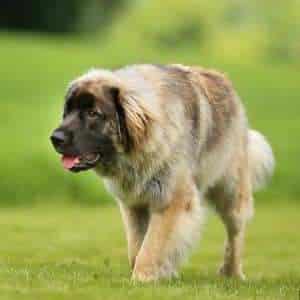
The Leonberger gets its name from the German town, Leonberg, where thy originated. While purporting to have an early beginning, most of these dogs were lost during the World Wars. This a heavy dog, weighing up to 200 lbs.
Only 8 Leos survived World War II and all modern Leonbergers can be traced to these 8 dogs. Today they serve as search and rescue, water rescue dogs and family companions.
They are very affectionate, eager to please, and fairly easy to train. They make good watch dogs, although they are generally calm and quiet indoors.
They need a daily walk, but also like to swim and even pull carts. Prepare for some coat care including brushing several times a week.
Maremma

The Maremma Sheepdog, pronounced (“mare-emma) is an Italian livestock guarding dog which means that they are naturally protective, independent and untrusting of strangers. They are affection with anyone they consider to be family but may be unpredictable with everyone else.
There is some controversy about whether these dogs make good companions. Their parent club in the U.S. suggests they are better off as working dogs living on farms or ranches. With the right owner they can be socialized and trained to live peacefully with a family, but it requires a great deal of work.
Mastiff (aka. English Mastiff)
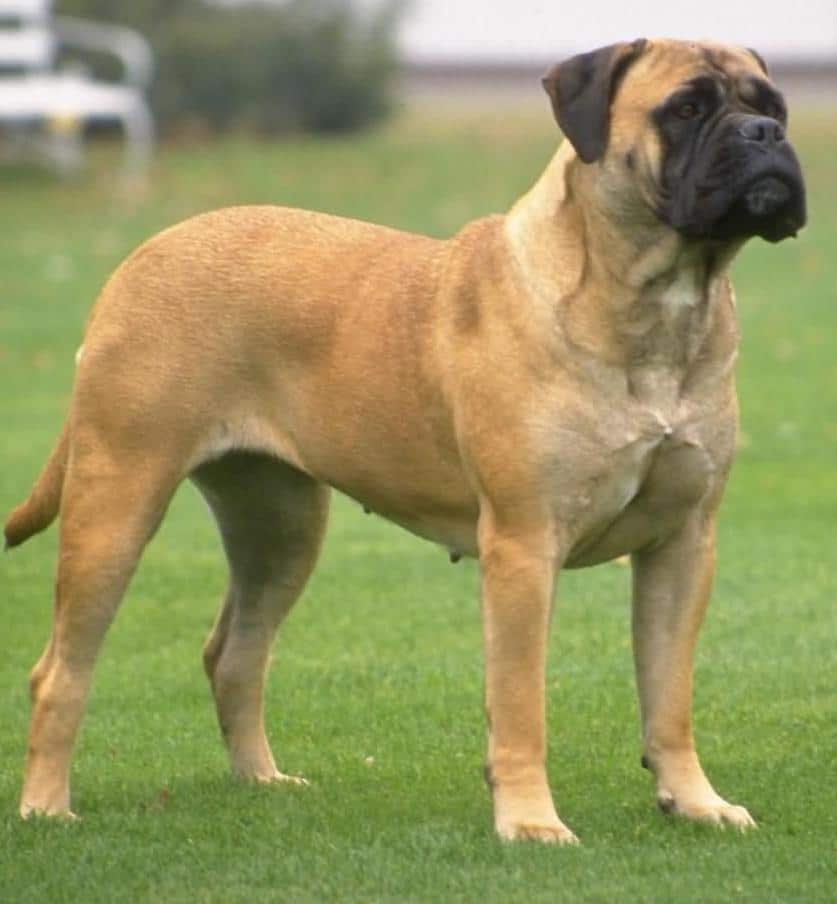
A calm and confident breed, the Mastiff is amiable and good with children. The original mastiff-type dogs date back thousands of years, but the modern Mastiff emerged around 1880 and shortly after. Male dogs can weigh up to 230lbs and stand 30 inches at the withers.
Neapolitan Mastiff
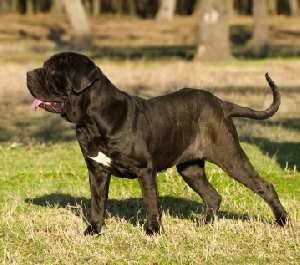
Descended from Roman Molossus fighting dogs, the Neapolitan Mastiff has an intimidating appearance with an extra huge head and severe expression.
At a height of between 24-30 inches (60-70 cm and a weight of 110-154 pounds (50-70 kg), they make formidable guard dogs.
Although loyal and loving to his family, these dogs should only be owned by skilled owners willing to take the time to train and socialize them properly.
Newfoundland
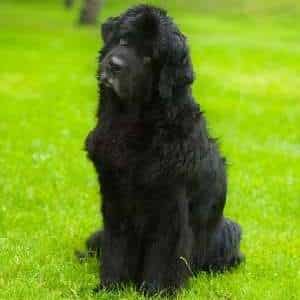
The Newfoundland dog breed is perfect for someone who wants a large, easygoing dog that can also double as a lifeguard.
These sweet dogs are known to be great for families as well as sole owners. Their social personalities make them suitable for houses with a lot of people going in and out. This breed is not known to be too intense either, making them suitable for most owners including first time dog owners.
Known as the Gentle Giants of the Dog World, they can grow to be 150 pounds and 28 inches tall at the withers. They love to swim, so if you live near water, this could be an ideal breed for you, but it doesn’t do well in hot weather.
Portuguese Mastiff (Rafeiro do Alentejo)
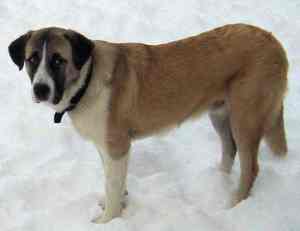
The Portuguese Mastiff, also know as the Rafeiro do Alentejo is an excellent, self-confident guard, as the name implies. They are not for the novice dog owner, but for experienced, authoritative owners, they are calm, brave, and ever watchful. They can be stubborn and dominant, but are not considered aggressive.
Consistent early socialization is a must for these dogs and ongoing obedience training should be a priority. They are seasonal shedders, but require little coat care on a daily basis. Their exercise demands are not as great as some breeds, but they do need a daily walk to keep them in shape.
As with most large and giant breed dogs, the males are generally larger than the females. Males can average 28 inches in height and weight up to 132 pounds. Females usually stay below 121 pounds, but still a formidable size for a pet. They are a rare breed and may need to be imported from their native Portugal.
Pyrenean Mountain Dog (Great Pyrenees)
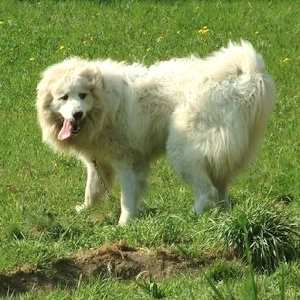
The Great Pyrenees is a large breed of fun, affectionate dogs. They love to be with their family and owners but are not quite as warm to strangers.
Having been used mainly as herding dogs in the past, instinct makes these dogs typically a bit more awake during the night, and sleepier during the day.
They are calm, gentle and do well with children. As with other guardians, they have an independent, sometimes stubborn nature and may try to dominant a less secure owner.
Their average height is 25-32 inches. (64-81 cm) Their average weight is 85-120 lbs. (39-54 kg).
Rottweiler
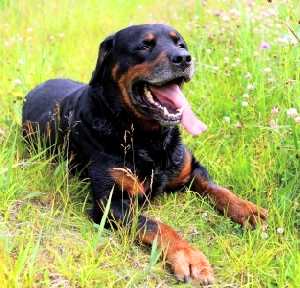
No list of giant dog breeds would be complete with mentioning the Rottweiler.
These dogs have a long history and it is said they accompanied Roman armies all over the Alps, herding livestock, guarding, and pulling carts.
By the twentieth century, they were given a new job, that of a police dog. While not as big as some on this list, their size, and strength warrants mentioning.
They are intelligent and loyal with strong protective instincts. Training and socialization at a very young age is a must and owners who take charge as the alpha are the most successful.
Rottweilers generally do well with children, but supervision and teaching children to respect dogs is very important especially when it comes to Rottweilers. They are approximately 22 to 27 inches at the withers and can be between 85 and 130 pounds full grown.
Russian Black Terrier (Tchiorny Terrier)
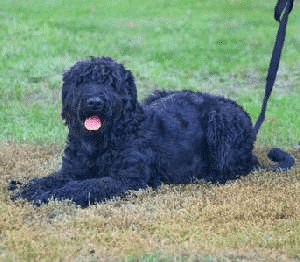
Despite their name, these dogs are not true terriers, but rather intelligent, independent guard dogs. In the U.S., they are still a very rare breed, so them may be hard to find.
These “Black Pearls of Russia” are people oriented, very loyal and enjoy the company of children. They are aloof with strangers and may have problems with other dogs.
You have one choice of color as the name implies and their coat does require some work. At 30 inches at the withers and up to 140 pounds, there are few intruders that will get by these guards.
They do best with firm consistent owners who have had a decent amount of experience around dogs. They are easy to house train as most large breeds are, but being on the stubborn side with an independent streak, they make take a little longer to accept your authority.
Saint Bernard

Descended from mastiff dogs that migrated through Switzerland during Roman times, the Saint Bernard is considered the world’s largest dog, if not the tallest. These muscular dogs were used as draft animals, able to pull heavy loads on icy slopes.
Mostly docile, good natured and loyal, they relate well to children and make decent if not huge family pets. With a weight at upwards of 175 pounds (80 kg) and a height of 27 to 31 inches (65-80 inches), these dogs require gentle but firm owners with a big house.
Scottish Deerhound

Despite his great size, these giants won’t guard your house, or even serve as a watchdog. You might not be able to get them to play tug of war or fetch with them, so what is it that makes them so different?
They are scent hounds, born to run, and one of these dogs in motion is a sight to see. They need plenty of room to do what they love to do, but be sure it is a well fenced in area otherwise you may never see your Deerhound again, because they have an extremely strong prey drive.
They love their family and are generally fine with children and other dogs. They are even happy to see strangers. Expect to spend time socializing and exercising them, but their coat care is not extensive. At 32 inches and 110 pounds, if you want a giant dog that will greet strangers with friendliness, this is your dog!
Shiloh Shepherd
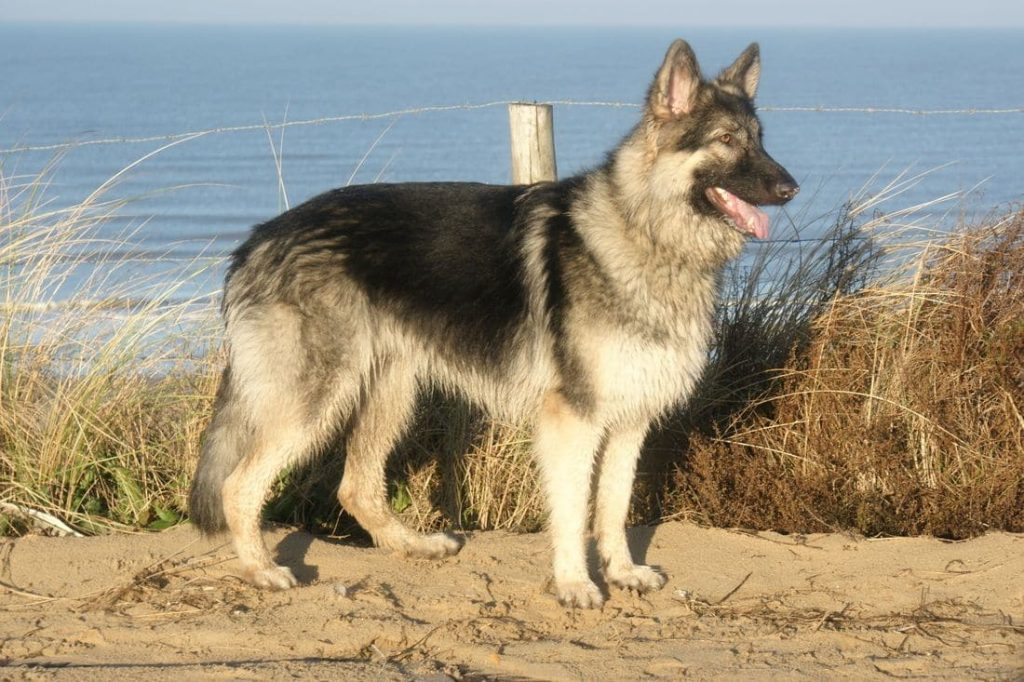
This relatively recent American breed weighs in at 100 lbs on average. It is the result of a selective breeding program that originally crossed the German Shepherd with the Alaskan Malamute. The aim was to produce a calm and amiable companion dog with better health than typical German Shepherds.
South Russian Sheepdog
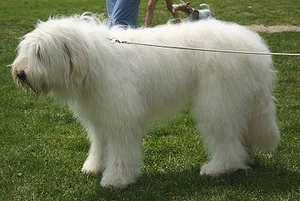
This breed goes by many different names depending on where you are in the world: loujnorousskaïa Ovtcharka, Ukrainian Ovcharka, Yuzhak, South Ukrainian Ovcharka, South Russian Shepherd Dog, Yuzhnorusskaya Ovcharka.
This is the most biddable of all the Russian Sheepdogs and not to be owned by the faint of heart. They are loyal and good with children but require a great deal of exercise and room to move. Though known world-wide, this breed is rarely seen outside of Russia. They weigh in between 110 and 140 pounds.
Spanish Mastiff

This rarely seen breed arrived in Spain over 2000 years ago by Phoenician traders. Also called Mastin de Extremadura or Mastin de la Mancha.
The Spanish Mastiff has been protecting livestock from wolves for over 600 years but today, most of these dogs serve as guardians for families and homes.
Males can be aggressive with other dogs, but generally do well as a family companion. At 121 -154 pounds (55-70 kg) and 28 to 32 inches (72-82 cm), these Spanish Dogs can be a formidable guard that requires extensive training and early socialization.
Tatra Mountain Sheepdog

There are several very large white mountain dogs that originate in Central Asia, but the Tatra Mountain Sheepdog is the largest. Also known as the Owczarek Tatranski or Polish Tatra Mountain Sheepdog, these dogs were used to guard flocks and pull carts. They are independent by nature, but bond very closely with people.
They are gaining in popularity in Poland and elsewhere in Europe but very rare outside of these areas. Grooming and Training require some time and don’t expect to get these dogs in any color other than white. They are between 99 and 152 pounds (30-52 kg) and 26-30 inches high (66-75).
Tibetan Mastiff

The father of all Mastiffs, the Tibetan Mastiff is the largest of the many mastiff breeds weighing in at between 141 and 180 pounds (64-82 kg.).
They are considered to be a primitive dog (meaning they only have one estrus per year as opposed to the normal two of most dog breeds). They are highly intelligent and very independent. These two personality traits translate into this: They learn commands quickly, but decide for themselves whether they will do what you ask.
Once a giant livestock guarding dog in the Himalayas, today’s dogs are easier going, if not just a little aloof. Still retaining a strong protective instinct, they enjoy a cool climate and make a good family pet.
Turkish Akbash
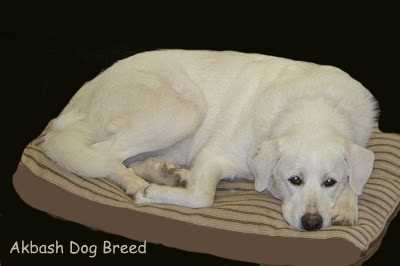
The Turkish Akbash goes by a variety of names including the Akbash, Turkish Sheepdog, Akbas, Coban Kopegi. Like other livestock guardians, the Akbash is calm, strong and independent. It is a working dog that takes its job very seriously and will defend his charges to the death if need be.
They make excellent livestock guardians and have been know to guard a wide variety of animals including sheep, goats, horses, cattle, poultry and even llamas. They are used in the western states of the U.S. to guard against coyotes and even bears.
It is debatable if they make a good companion dog without a job to do. It takes a special kind of highly experienced owner if these dogs are to do well as a family pet. At 90-121 pounds (41-55 kg) and a whopping height of up to 34 inches (86 cm) they can make a formidable guard to protect you.
